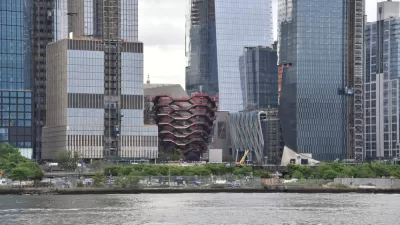Explore how data-driven research is revolutionizing sustainable urban development, creating smarter, greener, and more resilient cities for the future.

As technology advances, researchers discover new ways to optimize the built environment. With sensors, artificial intelligence (AI) and surveillance systems, they gain access to massive datasets that provide insights into pedestrian behavior, traffic patterns, environmental factors, energy consumption rates and more. Could big data reshape how urban planners approach environmentally conscious development?
How Big Data facilitates sustainable city development
The more planners know, the better their designs. This fundamental principle is driving the adoption of big data solutions. Sustainable smart cities increasingly leverage these technologies to develop and apply more novel, sophisticated urban planning and operational management solutions.
Big data reveals how people move in and use urban areas. With sensors, cameras and AI, planners can generate insights into traffic patterns, population density, and pedestrian flows. They can even peer into the hidden inner workings of wastewater, energy, and waste infrastructure.
Mapping pedestrian and vehicle patterns is helpful. However, that is not the only way professionals can leverage this technology. They can track sunlight coverage, air pollution, or wind intensity metrics to inform environmental monitoring, improve resource allocation, and enhance renewable installation planning.
Applications of data analytics in urban planning
Professionals can collect information on traffic patterns to improve air quality and mitigate vehicle-generated greenhouse gas emissions. Say they discover air pollution sharply rises when traffic lights turn yellow because drivers accelerate to avoid stopping at the red light. With this knowledge, they would know to install roundabouts or warning lights signaling light changes.
Alternatively, studies could help monitor power consumption. Seeing how grid infrastructure, peak load, and population density correlate helps determine energy-efficient solutions.
Cities could use insights on sunlight, wind, hydroelectric, and geothermal availability to optimize renewable energy usage based on population density, compensating for surges in electricity demand.
Data-driven research could help city officials fund environmentally conscious projects. Tax incentives — like the research and development credit — require taxpayers to prove every dollar claimed is directly connected to a qualified project. Analytics eliminates guesswork, streamlining the process of funding allocation.
Using research to accelerate sustainable development is essential because urbanization is picking up speed. Experts predict that 70 percent of the world’s population will live in cities by 2050. Some estimates are even higher. With the right insights, policymakers and civil engineers can develop technology-backed, environmentally conscious solutions.
How urban planners have integrated data insights
Urban planners have successfully leveraged data-driven technology and research in various settings by incorporating them into traditional approaches.
Recently, Stockholm Central Station held a redevelopment competition for design, prioritizing pedestrian circulation and meeting strict environmental standards.
Stockholm Central Station is Sweden’s largest transportation hub, managing 80 percent of the country’s train trips, which 230,000 people take daily. Since the station was built in 1871, the city has outgrown it. Experts predict it will surpass its capacity limit by 2030 and experience a 50 percent increase in traffic by 2045. It must expand while meeting sustainability requirements.
Urban Design Group — a professional architectural and design services firm — leveraged geographic information system techniques and spatial models to evaluate Stockholm’s topography and the built environment, ultimately winning the design competition.
The winning design turned the country’s busiest hub into a mixed-use district, increasing pedestrian flows by 70 percent and open public space by 50 percent. Urban Design Group’s project demonstrates the effectiveness of data technologies in complex real-world scenarios.
Reshaping urban development with data analytics
Extracting insights from vast datasets helps professionals create more livable, efficient, and environmentally responsible cities. As smart cities become more prevalent, this level of granularity will become standard. In time, it could help entire countries view sustainability through a new lens.

Planetizen Federal Action Tracker
A weekly monitor of how Trump’s orders and actions are impacting planners and planning in America.

Congressman Proposes Bill to Rename DC Metro “Trump Train”
The Make Autorail Great Again Act would withhold federal funding to the system until the Washington Metropolitan Area Transit Authority (WMATA), rebrands as the Washington Metropolitan Authority for Greater Access (WMAGA).

The Simple Legislative Tool Transforming Vacant Downtowns
In California, Michigan and Georgia, an easy win is bringing dollars — and delight — back to city centers.

The States Losing Rural Delivery Rooms at an Alarming Pace
In some states, as few as 9% of rural hospitals still deliver babies. As a result, rising pre-term births, no adequate pre-term care and harrowing close calls are a growing reality.

The Small South Asian Republic Going all in on EVs
Thanks to one simple policy change less than five years ago, 65% of new cars in this Himalayan country are now electric.

DC Backpedals on Bike Lane Protection, Swaps Barriers for Paint
Citing aesthetic concerns, the city is removing the concrete barriers and flexposts that once separated Arizona Avenue cyclists from motor vehicles.
Urban Design for Planners 1: Software Tools
This six-course series explores essential urban design concepts using open source software and equips planners with the tools they need to participate fully in the urban design process.
Planning for Universal Design
Learn the tools for implementing Universal Design in planning regulations.
Smith Gee Studio
City of Charlotte
City of Camden Redevelopment Agency
City of Astoria
Transportation Research & Education Center (TREC) at Portland State University
US High Speed Rail Association
City of Camden Redevelopment Agency
Municipality of Princeton (NJ)






























